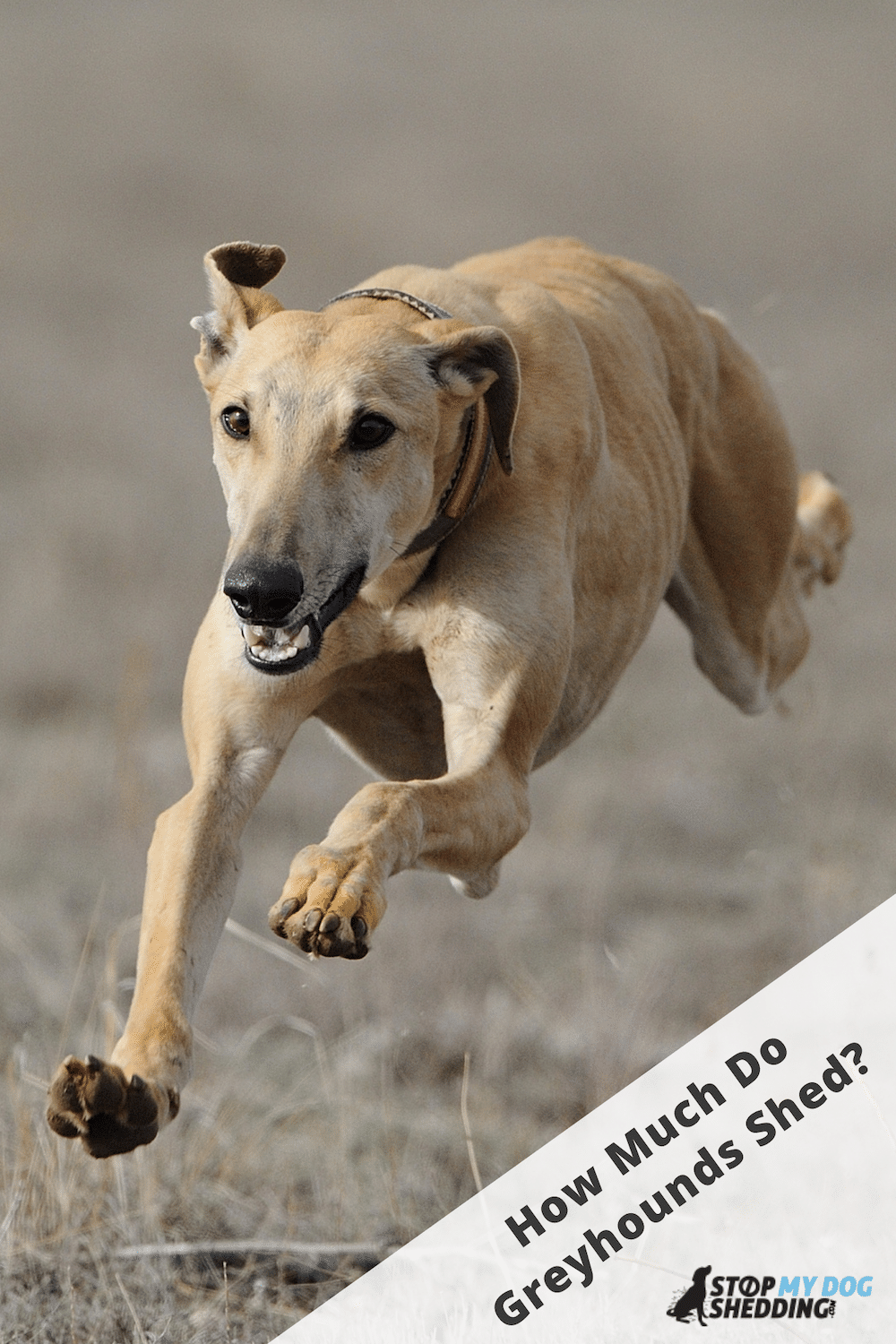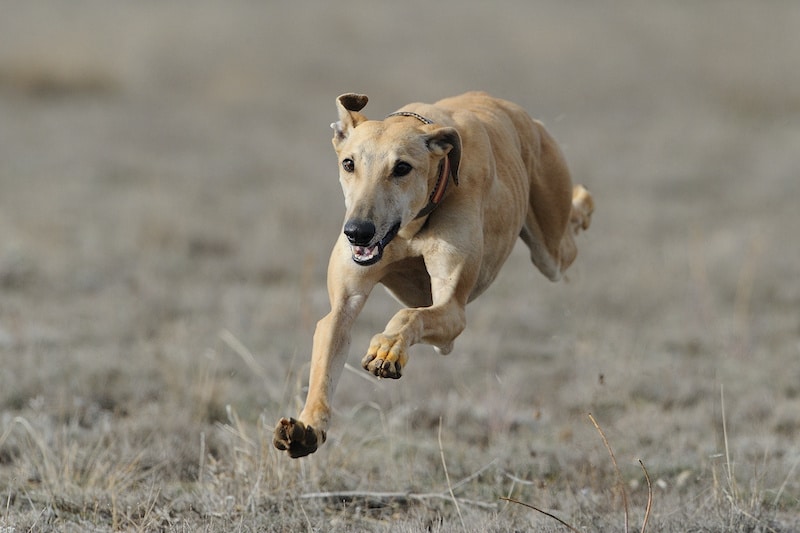Greyhounds are a large breed of hound with a history dating back to ancient Egypt. They’re also the fastest dogs on earth, and when they’re not running, love to be lazy couch potatoes.
Do they shed lots? The Greyhound is a moderate shedding breed with a short, easy to maintain coat. They do lose more fur during seasonal changes such as fall and spring, but overall they aren’t heavy shedders. Regular brushing with a soft bristle brush is the best way to keep his coat healthy and reduce the amount of hair they drop around the home.
Read on to learn more about why Greyhounds shed, what they’re like to groom and some of the unique characteristics that make them so special.
Greyhound Shedding (What to Expect)
Greyhounds are a moderate shedding breed.
To give you an idea of what “moderate” means, they’re not as heavy shedding as a Great Dane, but do shed more than a Saluki and their smaller counterparts, the Whippet, for example.
Greyhounds have a short, single coat that is very easy to maintain though, so keeping the hair loss to a minimum is as simple as brushing regularly.
With that being said, you should expect to see the rate of shedding pick up a couple times per year, normally during spring and autumn. They tend to shed more during this time as their coat prepares for the change of season ahead.
During this time, you may want to brush daily, instead of once or twice per week, to keep as much hair off of your furniture, clothing and floor as possible.
Either way, shedding is completely normal in most dogs. So you shouldn’t try to stop it completely. Nor is it possible to do so. There are certainly some ways you can reduce it though which we will be discussing further along in the article. But for the most part, it comes down to brushing.
Are They Difficult to Groom?
Grooming your Greyhound is very simple, they’re a low maintenance breed that does well with a brush once or twice per week.
Their coat comes in a variety of colors but probably the most common is black, red, brindle, or white with markings in one of these colors. Regardless of the color, they have short, smooth coats that are very easy to brush.
The best type of brush to use is a soft bristle brush, which is a brush made of bristles that are well suited to dogs with short fur. You could also use a rubber hand mitt (hound glove) if you prefer.
If you have a Greyhound with a longer coat (because it’s not a purebred for example), or you just want to get on top of the shedding in a more efficient manner, then a deshedder could be worth checking out.
See our dog shedding brush reviews and buyer’s guide to learn more.
In any case, grooming your Greyhound is not difficult. They do shed some hair, but the ease of brushing more than makes up for this.
Aside from brushing, it’s important to perform all the regular grooming duties like nail trimming, cleaning their teeth and bathing.
Recommended: Go here to see our top-rated dog hair blow dryers
Are Greyhounds Hypoallergenic?
Greyhounds are not considered a hypoallergenic breed.
But the truth is that no dog is 100% perfect for allergy sufferers, even completely hair free breeds can still upset those who are sensitive to dog related allergens.
And this is because a lot of what makes us sneeze isn’t the hair itself, it is the dogs dander (AKA dead flaking skin) and dried up saliva. These two things are enough to cause allergies to flare up. It’s just worse when the dog sheds lots of hair because these allergens stick to the hair and therefor spread more easily around the home.
So, generally speaking, the less hair the dog loses, the more “hypoallergenic” it is, but even then it’s not completely hypoallergenic.
Either way, in the case of the Greyhound, they’re a moderate shedder so they’re not as bad as some breeds but they are far from being hypoallergenic.
Recommended: Go here to see our top-rated dog hair blow dryers
How to Minimize Shedding
The simplest and best way to minimize shedding in your Greyhound is to maintain a regular brushing routine. There’s no “quick fix” or “magic solution” here, it’s just a matter of brushing regularly.
And because they don’t shed much, and have short, smooth coats, this is a very simple task. A bristle brush or hound glove (or optionally a deshedding tool) is all you need to get the job done.
This will remove the hair and dander from his coat, keeping it off your floor and furniture as much as possible, and will also help him to maintain a healthy coat.
Because brushing distributes the coat oils, especially when you use a bristle brush. Which in turn promotes a healthier, more moisture rich coat. And that is one of the best things you can do to prevent excessive shedding.
The dryer your dog’s skin and hair is, the more he will shed. This is why it’s important to avoid over bathing, only use quality dog shampoo and feed him a well balanced, vet recommended diet.
These simple things (brushing, proper bathing, diet) can tip the battle of the hair in your favor. Especially since he doesn’t shed much to begin with.
Recommended: Go here to see our top-rated dog hair blow dryers
Should You Adopt a Greyhound?
The Greyhound (or English Greyhound) is a sighthound that has been around for over 5,000 years, dating back to the days of ancient Egypt, where Pharaohs used them to track and capture wildlife in the desert plains.
Sighthounds were bred to be quick and hunt prey with their keen eyesight, and that’s exactly what a Greyhound does best.
They’re a large breed of dog that runs faster than any other dog on the planet. In fact, he’s been clocked going up to 43 mph (70km per hour) within a 30 meter distance, which is incredible.
And this is why they are better known as racing dogs in our day. They participate in races all over the world, much like horses do. And if you’re into that kind of thing, it can be fun to watch!

In any case, the fact that they run so well has led some to mistakenly believe that Greyhounds need constant exercise throughout the day to be happy, but this simply isn’t true.
Greyhounds were bred for short bursts of intense sprinting, not endurance. So they’re actually quite happy to be couch potatoes most of the time. They do love a good run each day, and should get one, but they love chilling at home just as much.
Outside of play, they’re about as docile as they come, and are very affectionate towards those they know. They don’t bark very much either. So, believe it or not, as long as you give them a good run each day, they can actually make great apartment dogs.
Similar breeds, that also don’t shed very much, include the Italian Greyhound, Irish Wolfhound, Whippet and Saluki. But there are many others depending on your preference.
All in all, Greyhounds make great family companions. They do shed moderately, but considering how easy they are to groom, and their other great qualities, it’s easy to see why they remain so popular.













Please note: By submitting a comment using the above comment form, you confirm that you agree with the storage and handling of your data by this site as detailed in our Privacy Policy.